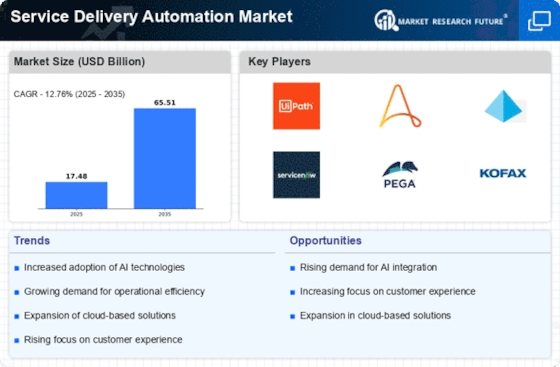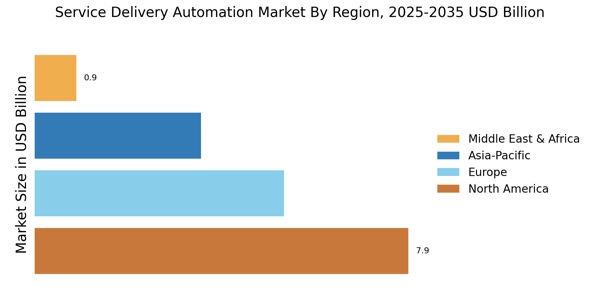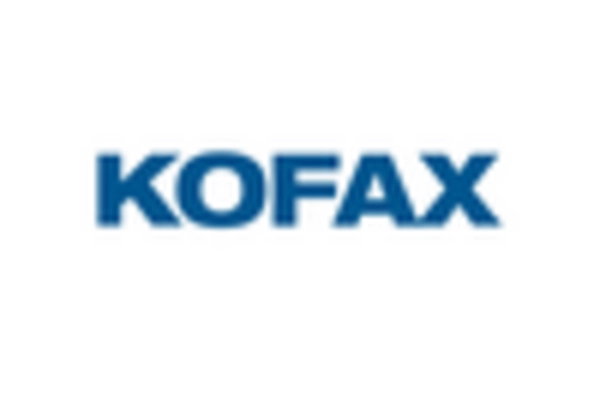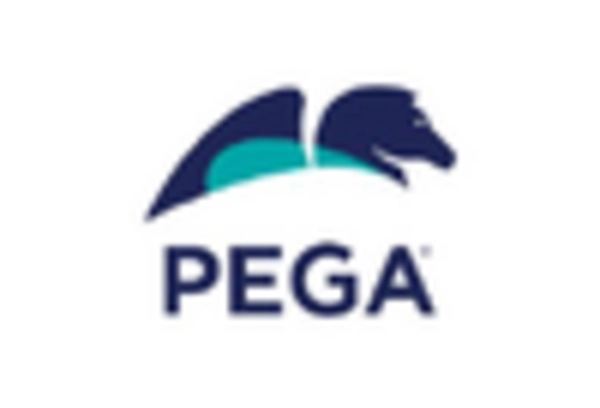Growing Adoption of Cloud Technologies
The Service Delivery Automation Market is witnessing a marked increase in the adoption of cloud technologies. As businesses transition to cloud-based solutions, they are finding that these platforms offer enhanced flexibility, scalability, and cost-effectiveness. The cloud enables organizations to deploy service delivery automation tools more efficiently, allowing for quicker implementation and reduced infrastructure costs. Recent market analysis suggests that the cloud segment of the service delivery automation market is expected to grow at a compound annual growth rate of over 20% in the next five years. This trend is indicative of a broader shift towards digital transformation, where organizations are increasingly relying on cloud solutions to enhance their service delivery capabilities. The integration of cloud technologies into service delivery automation is likely to reshape the market landscape, providing businesses with innovative tools to meet evolving customer demands.
Emphasis on Enhanced Customer Experience
In the Service Delivery Automation Market, there is a pronounced emphasis on enhancing customer experience. Organizations are recognizing that superior service delivery is crucial for customer retention and satisfaction. Automation tools are being deployed to streamline interactions, reduce response times, and personalize services. Data indicates that companies that prioritize customer experience through automation can see a significant increase in customer loyalty and engagement. This focus on customer-centric service delivery is driving investments in automation technologies that facilitate better communication and service personalization. As businesses strive to meet the evolving expectations of their customers, the Service Delivery Automation Market is likely to expand, with a growing number of organizations adopting solutions that enhance the overall customer experience.
Rising Demand for Operational Efficiency
The Service Delivery Automation Market is experiencing a notable surge in demand for operational efficiency. Organizations are increasingly seeking to streamline their processes, reduce costs, and enhance productivity. According to recent data, companies that implement service delivery automation can achieve up to a 30% reduction in operational costs. This trend is driven by the need to remain competitive in a rapidly evolving business landscape. As automation technologies advance, businesses are likely to adopt these solutions to optimize their workflows and improve service delivery. The emphasis on efficiency is not merely a trend; it appears to be a fundamental shift in how organizations approach service management. Consequently, the Service Delivery Automation Market is poised for substantial growth as more enterprises recognize the value of automation in achieving their operational goals.
Regulatory Compliance and Risk Management
The Service Delivery Automation Market is increasingly influenced by the need for regulatory compliance and effective risk management. Organizations are facing mounting pressure to adhere to various regulations and standards, which necessitates the implementation of automated solutions to ensure compliance. Automation tools can help streamline compliance processes, reduce the risk of human error, and enhance reporting capabilities. Recent findings suggest that companies that utilize automation for compliance purposes can reduce their compliance costs by up to 40%. This trend highlights the critical role of service delivery automation in managing regulatory requirements and mitigating risks. As the regulatory landscape continues to evolve, the demand for automation solutions that support compliance efforts is expected to grow, further propelling the Service Delivery Automation Market.
Increased Focus on Data-Driven Decision Making
In the Service Delivery Automation Market, there is a growing emphasis on data-driven decision making. Organizations are leveraging analytics and insights to inform their service delivery strategies. The ability to analyze customer data and operational metrics allows businesses to make informed decisions that enhance service quality and customer satisfaction. Recent studies indicate that companies utilizing data analytics in their service delivery processes can improve their service response times by up to 25%. This trend underscores the importance of integrating data analytics into service delivery automation solutions. As organizations strive to enhance their decision-making capabilities, the demand for automation tools that facilitate data analysis is likely to increase. This shift towards data-driven approaches is expected to significantly influence the trajectory of the Service Delivery Automation Market in the coming years.


















Leave a Comment